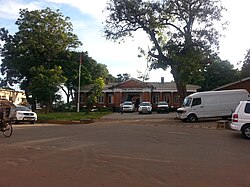Zomba District
Zomba District | |
|---|---|
 Zomba District Council | |
Location of Zomba District in Malawi | |
| Country | Malawi |
| Region | Southern |
| Seat | Zomba |
| Area | |
| • Land | 2,363 km2 (912 sq mi) |
| Population (2018) | |
| • Total | 746,724 |
Zomba District is one of twelve
Geography
Zomba District is bounded on the north by Machinga District, on the east by Mozambique, and on the south by Phalombe, Mulanje, and Chiradzulu districts, on the southwest by Blantyre district, and on the northeast by Balaka District.
The Shire River forms the northwestern boundary of the district, and the northwestern portion of the district lies in the Shire River Valley, a portion of the East African Rift. The Shire Highlands run from north to south through the district, including the Zomba Plateau. The highlands form the divide between the Shire River basin and the basin of Lake Chilwa. The Phalombe Plain lies east of the highlands and west and south of Lake Chilwa. The central and eastern portions of the district lie in the closed basin of Lake Chilwa, and several small rivers drain from the surrounding highlands into the lake. The Domasi River forms part of the northern boundary of the district. The Phalombe River and its tributary the Namadzi form the southern boundary of the district, separating it from Phalombe, Mulanje, and Chiradzulu districts. The Likangala River and its tributary the Thondwe River drain the central portion of the district eastwards into lake Chilwa. Lake Chilwa's extent varies with rainfall and evaporation, and the lake is surrounded by broad seasonal wetlands.
Demographics
The district has a total population of 746,724 (2018) resulting in a population density of 316 persons per km2, more than half (52.6%) of whom are 18 years or younger. The annual population growth rate over the last decade was two percent.
(20%).Ethnic groups
At the time of the
- 23.1% Lomwe
- 47.3% Yao
- 21.7% Nyanja
- 5.8% Chewa
- 3.6% Mang'anja
- 2.1% Ngoni
- 0.6% Sena
- 0.3% Tumbuka
- 0.1% Tonga
- 0.0% Nkhonde
- 0.0% Lambya
- 0.0% Sukwa
- 0.3% Others
Government and administrative divisions
There are ten
- Zomba - Central
- Zomba - Changalume
- Zomba - Chingale
- Zomba - Chisi
- Zomba - Likangala
- Zomba - Lisanjala
- Zomba - Msondole
- Zomba - Mtonya
- Zomba - Nsondole
- Zomba - Thondwe
Since the
- Zomba City (administrative capital)
Economics
The economy of Zomba District is dominated by agriculture, where individual maize production accounts for the main activity, while tobacco is cultivated as the main cash crop. Other crops produced include rice, cassava, sweet potato, groundnuts, beans and pigeon peas. Husbandry is still underdeveloped; nevertheless cattle, poultry, goats, sheep, pigs and rabbits are raised for meat production in Zomba, with poultry being the most common. Zomba on the other hand is one of the few districts with well-spread pond-fishing. There are around 2,600 farmers engaged in aquaculture, operating more than 5,000 ponds and producing as much as 757 tonnes of fish annually. In addition, Lake Chilwa continues to be the main source of fish in the district, with an annual catchment of more than 5,000 tonnes.
Small and medium-scale businesses dominate the district's non agro-based economy, with general retail accounting for the gross of sales. Employment has increased to almost 97% of the total adult (15+) population, resulting in historically low unemployment. Services, general labour, and professional and technical groups are the dominant occupation groups.
Ecology
The district extends across four
Most of the district's native forests have been cleared for agriculture or plantations of introduced pines (Pinus patula) and eucalyptus.
Tourism
Tourism plays an increasing role in the district's economy. Attractions include the Zomba Plateau and Lake Chilwa, historical relics and the natural environment of the district.
Health
Health services are provided mainly at health posts, clinics, health centres and hospitals. In addition, many people get medical treatment from traditional practitioners and traditional birth attendants. The crude birth rate for the district is estimated at 48.1 births per 1,000 Inhabitants. The total fertility rate stands at 5.3 children per woman. The infant mortality rate is 84 deaths per 1,000 live births and child mortality (14.4%) is among the highest in the country.
Infrastructure
Almost four-fifths of all households (79.6%) have access to safe drinking water, while access to sanitation facilities is still at 59%. Methods of refuse disposal include burning, dust bins, rubbish pits, random littering and, mainly for organic waste, integrating into garden and composite pits.
Education
Education in Zomba District is offered from pre-school, primary, secondary and tertiary levels to adult literacy classes and vocational training. The services are provided by the government, religious institutions and private individuals. The district has experienced a sharp increase in school enrolment. Primary school net enrolment is currently at 87.2% against the country rate of 80.0%. However, the education sector in Zomba at all levels continues to face a number of challenges, including teacher qualification, shortages in the total number of teacher and student accommodations, lack of or dilapidated classrooms and lack of teaching materials.
Transportation
Zomba District is comparatively well connected. The main road passing through the district is the M3 road (Blantyre-Zomba-Lilongwe). The Zomba Phalombe road is under construction. Earth roads comprise many of the other types of roads connecting different places within the district. Bicycles and matola (hitch-hiking) are the most common means of transport, followed by regular buses and minibuses.
